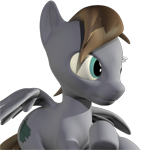It's kind of hard to explain, but whenever I produce a track, it sounds very "empty." I have no way to describe it better than it just sounds very empty. When I listen to other tracks, they sound complete and full a rich, just in terms of the overall sound.
A few things that might help me:
• When making a track, what kinds of stuff do you use?
-Example: Basses, leads, moving lines, chords, etc.
• How do YOU make a track feel "full?"
–Example: White Noise, chords, etc.
• Anything else I should know?
P.S: I know that there are many Mastering threads here, but I'm more interested in getting a track to sound "full" over just one sound. I have no idea what I'm really talking about when I mention "empty" or "full," though, so really, anything would help. Thanks!
Quick Question About "Track Fullness"
9 posts
• Page 1 of 1
Quick Question About "Track Fullness"
You can just call me Decmaster.
My DAW: Logic Pro 9
My Soundcloud
My YouTube account
Rainbow and REJECTED
My DAW: Logic Pro 9
My Soundcloud
My YouTube account
Rainbow and REJECTED
-

Decmaster IX - Posts: 75
- Joined: 17 Jan 2012 21:01
Re: Quick Question About "Track Fullness"
That gives me trouble to this very day, good question.
-

Legion - Posts: 469
- Joined: 10 Mar 2012 22:46
- Location: Detroit
Re: Quick Question About "Track Fullness"
It really depends on the track. If I want it to sound FULL, then there's a lot of stuff that goes into it. If you don't mind a quick shameless plug, around two minutes in, this is what's playing:
That buzzy lead (I like buzzy leads like that because they fill up a lot of high frequencies and sound big.)
A subdued lead harmonizing with the main lead
A stabby synth playing a countermelody
The piano, playing both the melody, harmonized melody, and chords
Another stabby synth doubling the piano chords
Drums (Kick, snare, and hi-hats with plenty of delay on them)
Sub bass
Pads
Filtered white noise sweeps
So it's partially in the arrangement and partially in what sounds you use. The easiest thing to do would be to use a fuller-sounding lead, busier drums, a sub bass, pads, and white noise. The best thing to do, however, is introduce harmonies and countermelodies. They don't even have to be prominent -- just there to make the whole thing sound busier and fill up empty space, if you have any. And if you can make that countermelody play off the main melody so it changes notes when the main melody is standing still, you'll have something that sounds a lot fuller than you'd otherwise have.
Doubling important parts with other instruments is also fun, though then you have to be sure to EQ them correctly so they don't fight for the same sonic space.
Effects-wise, chorus is fun, as are stereo wideners. One thing I did with my pads is I duplicated the track, hard-panned them left and right, and then EQ'd the two tracks differently. For things that have more definite attacks, you can do the same thing, but introduce an offset between the two, so one triggers a little after the other. That'll widen the stereo presence while making it sound fuller.
That buzzy lead (I like buzzy leads like that because they fill up a lot of high frequencies and sound big.)
A subdued lead harmonizing with the main lead
A stabby synth playing a countermelody
The piano, playing both the melody, harmonized melody, and chords
Another stabby synth doubling the piano chords
Drums (Kick, snare, and hi-hats with plenty of delay on them)
Sub bass
Pads
Filtered white noise sweeps
So it's partially in the arrangement and partially in what sounds you use. The easiest thing to do would be to use a fuller-sounding lead, busier drums, a sub bass, pads, and white noise. The best thing to do, however, is introduce harmonies and countermelodies. They don't even have to be prominent -- just there to make the whole thing sound busier and fill up empty space, if you have any. And if you can make that countermelody play off the main melody so it changes notes when the main melody is standing still, you'll have something that sounds a lot fuller than you'd otherwise have.
Doubling important parts with other instruments is also fun, though then you have to be sure to EQ them correctly so they don't fight for the same sonic space.
Effects-wise, chorus is fun, as are stereo wideners. One thing I did with my pads is I duplicated the track, hard-panned them left and right, and then EQ'd the two tracks differently. For things that have more definite attacks, you can do the same thing, but introduce an offset between the two, so one triggers a little after the other. That'll widen the stereo presence while making it sound fuller.
-

Versilaryan - Posts: 453
- Joined: 03 Jul 2011 17:58
Re: Quick Question About "Track Fullness"
One way to get a track sounding full is using a lot of reverb and delays panned around the stereo field. Adding really spaced out synths with long attacks and releases that play the same notes as the lead helps too, as ways keep this far behind the mix so its there bhut you can hardly hear it. Long crash cymbals of filter sweeps can help too but you have to do them right so they don't sound intrusive.
4thImpulse's Youtube
Intro to DJing --- Guide on giving feedback --- Most detailed frequency chart you will ever see
Intro to DJing --- Guide on giving feedback --- Most detailed frequency chart you will ever see
-

the4thImpulse - Posts: 1578
- Joined: 22 Feb 2012 17:10
- Location: Kelowna, B.C.
- Primary: Ableton Live 8
- Cutie Mark: Blank flank
Re: Quick Question About "Track Fullness"
I usually play a melody on guitar, harmonize it with a synth, play a sub-bass under it, have a drum pattern with interesting stereo hats and stuff going on, and maybe add a few pads. From there, EQing makes it sound like everything isn't trying to strangle everything else.
-

colortwelve - Posts: 1187
- Joined: 18 Feb 2012 12:55
- Location: Los Angeles, CA
Re: Quick Question About "Track Fullness"
Decmaster IX wrote:It's kind of hard to explain, but whenever I produce a track, it sounds very "empty."
I have that problem sometimes...
I usually fix it in a simple way: I use really large, layered basses... and I really try to hammer on as much drum beat as I can.
I rarely actually publish my work, though. I really don't feel like I'm good enough yet.
I put up two things so far. Mostly as "trial runs" to see how people react.
Mostly positive, I think. I just wish I got more comments, rather than just likes or dislikes.
I feel that one of my favorite artist, The Living Tombstone, makes his tracks "full" by literally making them full. Listening with my headphones, I can really hear all the different synths he puts into his work. It's really a lot, and most of them might go unnoticed without paying attention to try to hear them.
- AlicornBob
- Posts: 36
- Joined: 10 Apr 2012 07:22
Re: Quick Question About "Track Fullness"
Mastering is about getting your track to sound loud. Mixing is where all the magic happens to get your song sounding full.
If you already have enough instruments (which shouldn't be that many IMO), you now have the battle of figuring out which tracks to pan, delay, adjust EQ, etc.
Leaving everything center and barely touching EQ will make your song sound flat, muddy, and/or clip easier.
What I like to do is visualize I'm sitting in the center of a concert hall, and imagine all my instruments as live players on stage.
For orchestral arrangements, I typically pan instruments based on their relative positions in a live orchestra. High strings panned slight left, low strings slight right. Piano panned little more left. Irregular percussion instruments to the right.
For drums though, you don't want to pan them like a live orchestra (unless you're really going for a full orchestral simulation). Generally, you adjust drums the way you would be sitting at them. Bass drum centered. Snare slight left. Hi-hats more left. Cymbals stereo-widened so they're both slight left and right. Crash/ride cymbal right. Toms slight right.
Creative panning techniques plus careful EQ adjustment can make your track sound very full.
If you already have enough instruments (which shouldn't be that many IMO), you now have the battle of figuring out which tracks to pan, delay, adjust EQ, etc.
Leaving everything center and barely touching EQ will make your song sound flat, muddy, and/or clip easier.
What I like to do is visualize I'm sitting in the center of a concert hall, and imagine all my instruments as live players on stage.
For orchestral arrangements, I typically pan instruments based on their relative positions in a live orchestra. High strings panned slight left, low strings slight right. Piano panned little more left. Irregular percussion instruments to the right.
For drums though, you don't want to pan them like a live orchestra (unless you're really going for a full orchestral simulation). Generally, you adjust drums the way you would be sitting at them. Bass drum centered. Snare slight left. Hi-hats more left. Cymbals stereo-widened so they're both slight left and right. Crash/ride cymbal right. Toms slight right.
Creative panning techniques plus careful EQ adjustment can make your track sound very full.
DAW: Cubase 6.5, Ableton Live 8
Preferred Genre: Industrial/Trance
Hardware: Schecter Diamond Series Bass, Yamaha Acoustic Guitar, BP355 Effects Pedal, Keystudio 49K Keyboard, Akai APC40, Korg nanoKEY2 25k Keyboard
Preferred Genre: Industrial/Trance
Hardware: Schecter Diamond Series Bass, Yamaha Acoustic Guitar, BP355 Effects Pedal, Keystudio 49K Keyboard, Akai APC40, Korg nanoKEY2 25k Keyboard
-

Navron - Global Moderator
- Posts: 955
- Joined: 14 Nov 2011 21:28
- OS: Windows 7
- Primary: Cubase 6.5
Re: Quick Question About "Track Fullness"
EQing isn't really a huge, huge part of achieving "fullness," especially since more often than not, you're cutting sound out with an EQ. It is very important, however, to try to get as much of the audible spectrum represented as possible, over as much "space" as possible, to give the listener a sense that air is actually vibrating outside of their headphones. If you're lacking in a part of the spectrum, it's worth it to try to fill that space with an instrument, or boost an instrument in that area to make it stand out more.
Mixing is a big part of that. What you really want out of your mix is roughly even perceptual loudness over the whole audible spectrum. If you don't have enough instruments to really achieve that, then you have no reason to let them overlap. Get them each a part of the spectrum where they're represented. This is really where EQ comes in, but it's more a means to an end, the end being that as much of the spectrum is used as possible.
Panning and stereo manipulation are actually very underrated ways of achieving "fullness." Giving each instrument a "position" will give a sense of space to the composition, and as three dimensional beings, humans need that sense of space to really become involved in the sounds they're hearing. Panning is actually not as big as stereo offset. At least toward the end of giving a position to an instrument, you should never need more than 25% in either direction. Any thing more, and you're probably making psy trance and trying to make the listener trip. But even with panning, you can fail to really give a sense of position. Offset is the part that actually makes it sound like an instrument has a location, because any sound that is not coming at you head-on, is going to be slightly delayed. In fact, the brain specifically adjusts for this very quality. You don't hear a sound in one ear then the same sound in the other ear; your brain interprets that by telling you the sound is coming "from" somewhere.
If you're really nerdy about binaural location, you can also filter each channel differently to mimic the fact that your body acts like a filter so that it sounds like instruments are coming from below or behind the listener.
Compression is also useful, since it generally has the effect of making the compressed track sound louder without significantly raising the volume. Just be careful you don't overdo it. Overcompression can actually remove important harmonics from a sound, and it can add non-resonant harmonics that ruin the track.
Mixing is a big part of that. What you really want out of your mix is roughly even perceptual loudness over the whole audible spectrum. If you don't have enough instruments to really achieve that, then you have no reason to let them overlap. Get them each a part of the spectrum where they're represented. This is really where EQ comes in, but it's more a means to an end, the end being that as much of the spectrum is used as possible.
Panning and stereo manipulation are actually very underrated ways of achieving "fullness." Giving each instrument a "position" will give a sense of space to the composition, and as three dimensional beings, humans need that sense of space to really become involved in the sounds they're hearing. Panning is actually not as big as stereo offset. At least toward the end of giving a position to an instrument, you should never need more than 25% in either direction. Any thing more, and you're probably making psy trance and trying to make the listener trip. But even with panning, you can fail to really give a sense of position. Offset is the part that actually makes it sound like an instrument has a location, because any sound that is not coming at you head-on, is going to be slightly delayed. In fact, the brain specifically adjusts for this very quality. You don't hear a sound in one ear then the same sound in the other ear; your brain interprets that by telling you the sound is coming "from" somewhere.
If you're really nerdy about binaural location, you can also filter each channel differently to mimic the fact that your body acts like a filter so that it sounds like instruments are coming from below or behind the listener.
Compression is also useful, since it generally has the effect of making the compressed track sound louder without significantly raising the volume. Just be careful you don't overdo it. Overcompression can actually remove important harmonics from a sound, and it can add non-resonant harmonics that ruin the track.
-

ph00tbag - Global Moderator
- Posts: 769
- Joined: 06 May 2012 16:19
- Location: Cary, NC
- OS: Windows
- Primary: FL Studio
- Cutie Mark: Blank flank
Re: Quick Question About "Track Fullness"
NavyBrony wrote:Mastering is about getting your track to sound loud. Mixing is where all the magic happens to get your song sounding full.
I see then...
Ignore me. Carry on...
- AlicornBob
- Posts: 36
- Joined: 10 Apr 2012 07:22
9 posts
• Page 1 of 1
Who is online
Users browsing this forum: No registered users and 3 guests

